U2樂團[編輯]
| U2 | ||
|---|---|---|
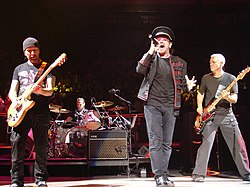 U2於麥迪遜花園廣場表演 (2005年11月)
|
||
| 組合 | ||
| 音樂類型 | 搖滾 後龐克 另類搖滾 流行 |
|
| 出道地點 | ||
| 活躍年代 | 1976年至今 | |
| 唱片公司 | MCA音樂公司/Interscope | |
| 網站 | U2.com | |
| 現任成員 | ||
| 波諾 The Edge 亞當·克雷頓 小賴瑞·慕蘭 |
||
U2是一支在1976年成立於都柏林的愛爾蘭四人制搖滾樂樂團,自1980年代竄起走紅之後,一直到了21世紀的今天,仍活躍於全球流行樂壇。音樂風格上,除了傳統的流行硬式搖滾之外,U2在1990年代也曾嘗試過一陣子較為實驗性的電子音樂作品。U2在創作內容方面涉獵非常廣泛,尤其不避諱政治性的話題,人權問題就是U2常常著墨的一種主題。由於其廣泛知名度與良好形象,U2成為愛爾蘭重要的國家象徵之一。
U2目前全球至少賣出超過1億4500萬張的專輯[1][2],並且榮獲22項葛萊美獎殊榮,是當今的樂團紀錄保持人[3]。滾石雜誌名列U2為「百年百大音樂家」中的第22位[4]。除了在樂壇有所成就外,U2的團員也是著名的社會活動家,關懷人權、社會問題、非洲飢荒、愛滋等議題。2005年獲得國際特赦組織良心大使獎。
目錄
[隱藏]
組成團員[編輯]
目前的U2有四位成員,分別是:
- 波諾(Bono):
- 原名保羅·大衛·休森(Paul David Hewson),是U2的主唱兼旋律吉他手,他的綽號源自於都柏林當地一家助聽器賣店「Bono Vox」(在拉丁文中意指「好嗓音」)。除了以U2樂團的團長而知名之外,Bono本身也具有非常高的個人知名度,是著名的社會活動家,並曾多次被諾貝爾和平獎提名。1960年5月10日出生於愛爾蘭都柏林。
- The Edge:
- 原名大衛·荷威·伊凡斯(David Howell Evans),是U2的主吉他手、鋼琴手與合音。The Edge的綽號是Bono取的,當初是Bono用來形容他的頭部線條所用的辭彙。曾有人說:「走紅以後The Edge一直留著光頭,似乎也有呼應強調這個綽號的用意。」但是事實情況——就像很多歌迷猜想的一樣——Edge確實有脫髮的問題,所以為了掩飾稀少的頭髮,他一直帶著一頂帽子。可是在參加Bono父親葬禮的時候,Edge將帽子脫去以表示對Bono父親的尊重,此時他稀少的頭髮清晰可見。Bono曾在演唱會上說:「Edge,他的大腦實在太發達了,所以不得不帶一頂帽子。」1961年8月8日出生於英格蘭東倫敦。
- 亞當·克雷頓(Adam Clayton):
- 小賴瑞·慕蘭(Larry Mullen, Jr.):
U2創立初期(當時團名是「The Hype」),原本有五位團員。當時吉他手The Edge的哥哥狄克·伊凡斯(Dik Evans)也在團中擔任吉他手,但他在1978年時離開、另組了樂團「處女梅」(Virgin Prunes)。
音樂歷程[編輯]
創團早年(1976-1979)[編輯]
1976年10月[5],當14歲、就讀於都柏林教堂山高中的小賴瑞·慕蘭,在學校的告示板張貼了一張成立新樂團、招募團員的告示時,就揭開了U2成軍的序幕。在經過了初步團練後,七個青少年合組了樂團「Feedback」(Feedback在音樂上是指吉他等弦樂器與音箱間的共鳴現象):由慕蘭擔任鼓手、保羅·休森(波諾)擔任主唱、大衛·伊凡斯(The Edge)與哥哥狄克·伊凡斯擔任吉他手、伊凡斯兄弟的友人亞當·克雷頓擔任貝斯手,最初的另兩位團員伊凡·麥寇米克與彼得·馬丁則分別在首次團練、數週後離團[5][6]。
1977年3月,樂團改名為「The Hype」[7]。1983年,波諾、慕蘭、大衛、克雷頓傾向組成四人樂團,於是較年長、顯得有些格格不入的狄克·伊凡斯便被「漸漸釋出」,狄克在一場告別演唱會結束後正式離團。1978年3月17日,樂團參加了一個於愛爾蘭利默里克舉辦的藝人選秀活動,並且順利拿到決賽的參加權。當時貝斯手亞當·克雷頓曾拜訪愛爾蘭著名的龐克搖滾大師史提夫·艾佛利爾(Steve Averill)討論樂團命名的問題,史提夫認為「The Hype」這個團名聽起來很糟,他們應該換一個響亮一點的團名。根據史提夫多年之後接受媒體採訪時的回憶,由於1970年代時樂壇流行採用有明顯意義的團名,因此他們反其道而行,尋找一個簡潔有力、可以牽扯出點道理、實際上又沒什麼緣由的字詞做為團名。當時亞當曾提議過他們想要像是「XTC」之類聽起來很有力但無明確意義的稱呼。後來,「U2」這團名雀屏中選,樂團也在決賽中獲勝贏得500英鎊的獎金,從此以後他們便以「U2」為團名闖蕩樂壇至今。
由於「U2」這個團名打從一開始就蓄意不想明指某種特定事物、又好像跟很多事物有所牽扯,因此該樂團的名稱一直是樂迷們非常愛爭論的話題。有的認為,U2這名字應該是源自美國空軍在冷戰時代所使用的U-2超高空偵察機,或者第二次世界大戰時的德國潛艇代號(德文:U-Boot),兩者都給人一種神秘莫測的感覺。但另一方面,也有人認為U2這團名象徵了該樂團的表演哲學,意指他們不單只是在台上表演給台下群眾觀賞,而是希望能與聽眾互動的「你也一起來」(You too)哲學。總之,這種種解釋可說是同時都對也同時都不對,各方解釋不同。
闖蕩樂壇:《男孩》、《十月》與《戰爭》(1980-1983)[編輯]
1980年3月,Island廠牌正式簽下U2,隨後在5月發行他們第一首國際單曲〈11 O'Clock Tick Tock〉[8]。同年10月,發行第一張專輯《男孩》,佳評如潮[9]。雖然從波諾的作詞當中看不出特定的焦點,但是隱約透露出身為青年的挫折與夢想[10]。發行專輯後,U2展開生涯首度歐美巡迴演唱,在他們早期的演出中,可以看出樂團的潛力,正如樂評所說,波諾是個具有領袖魅力以及熱忱的藝人[11]。
專輯的第二張專輯《十月》發行於1981年,主題比較偏向精神信仰。錄製期間,樂團因為信仰問題而停止了一段時期[12],這段期間團員與一個基督教團體「Shalom Fellowship」交往甚密,也讓他們意識到宗教與搖滾信仰之間的衝突[13]。更棘手的是,裝載著U2歌曲歌詞的公事包被偷走,而這項東西一直到2004年才被歸還,已經將近25年的時間[14]。這張專輯評價普通,讓U2面臨合約壓力,必須要在下一張專輯展現他們的潛力[15]。
走過了這段低潮期,U2在1983年發行第三張專輯《戰爭》,讓他們從「和平主義轉變為抗爭運動」[16]。專輯的代表作歌曲〈Sunday Bloody Sunday〉,透露樂團對於血腥星期日事件的不滿情緒[17],《滾石雜誌》稱讚這首歌曲證明U2也能寫出有深度意涵的歌曲。這張專輯也是U2首次與荷蘭攝影師安東·寇班合作的作品,他與樂團長期的合作關係不僅僅是封面拍攝,也同時開拓樂團的視野[18]。《戰爭》也是U2第一個暢銷專輯,在英國地區登上銷售榜首,另一首代表作〈New Year's Day〉是U2第一首紅遍全球的單曲[19]。
專輯隨後搭配的巡迴演唱會「戰爭世界巡迴演唱會」 (War Tour),在歐美地區巡迴,門票皆售光,波諾在演唱〈Sunday Bloody Sunday〉時揮舞著白色旗幟成為著名的景象[20]。U2在巡迴期間錄製現場專輯《血紅天空下》,拍攝演唱會影片《Red Rocks露天劇場演唱會》,在MTV以及廣播上皆獲得廣泛成功,被視為是傑出的表演團體[21]。1984年,U2與Island唱片商議合約事宜,雙方都承諾改進彼此的缺失,最後U2以更好的待遇續約[22]。
過渡火焰:《難忘之火》(1984-1985)[編輯]
U2的第四張專輯《難忘之火》發行於1984年,專輯的氣氛不在像《戰爭》那般肅殺,而是轉變的較為抽象與藝術,標榜著樂團大方向的改變[23]。樂團並不希望聽眾憑《戰爭》而將他們定位成「只會狂下標語的搖滾樂團」[24]。貝斯手亞當·克雷頓就說:「我們想要追求的是更加嚴肅也更加藝術的目標。[25]」The Edge傾慕名音樂人布萊恩·伊諾與丹尼爾·雷諾伊斯,於是他們首次合作製作專輯,他們良好的合作關係仍維持至今。
《難忘之火》內的聲調顯的較為圓潤舒適,旋律從以前的侵略性轉為流暢[26],歌詞帶有廣泛的涵義,被U2稱之為「視覺感受」[23]。波諾在涉獵小說、詩詞、哲學後,逐漸了解到他身為一個作詞家的責任,他以往不情願從事的作詞工作,也可以是個富含詩意的動作。波諾曾說過他覺得〈Bad〉、〈Pride (In the Name of Love)〉是未完成的「素描」,因為錄製的行程相當趕[27]。〈Pride (In the Name of Love)〉是U2獻給黑人民權鬥士馬丁·路德·金恩博士的歌曲,在當時紅極一時,被認為是U2的代表作之一。
「難忘之火巡迴演唱會」大多數的場次是在室內舉辦,U2這時的歌迷人數也有顯著成長[28]。錄音室錄製的歌曲舉凡〈The Unforgettable Fire〉、〈Bad〉等歌,要搬上舞台上表演卻有些麻煩,錄音室版本也飽受抨擊,認為是「未完成的」。唯一的解決方式是使用Sequencer,雖然樂團並不怎麼愛用,但是在現場表演上卻十分實用[23] 。上述的歌曲的現場版本評價也比錄音室版本好[29]。
1985年7月,U2參與一項國際盛事「巨星義助非洲慈善演唱會」 (Live Aid)[30],是樂團生涯中的大事紀[31]。樂團在這場盛宴中展現了他們的親和力[32],波諾曾跳下舞台與一女孩共舞(事實上後來這位女孩說是波諾救了她的命,因為她當時被群眾擠壓險些跌倒,是波諾親自跳下舞台幫助她脫困。[33])。1985年,《滾石雜誌》稱讚U2是「80年代最棒的樂團」「在搖滾樂蓬勃發展下,U2可說是最大功臣,而且可能是唯一功臣。[34]」
巔峰時期:《約書亞樹》與《神采飛揚》(1986-1989)[編輯]
在U2的好友巴布·狄倫、范·莫里森和凱斯·理查茲的建議下,樂團開始探索「根源搖滾」的領域,波諾也開始提升他的演唱作詞技巧[35]。基本上U2對於第五張專輯的期望是能保有《難忘之火》的特色,但又具備傳統歌曲的架構與規則[36]。在樂團錄製新專輯的期間,曾經暫停一段時間,他們參與由國際特赦組織舉辦的「希望陰謀」 (A Conspiracy of Hope)巡迴演唱會,這場演唱會對他們新專輯錄製而言有相當大的助益[37]。在1986年巡迴聖薩爾瓦多與尼加拉瓜的時候,他們看到當地農民受到美國調停國家內部動亂之苦,這寶貴的經驗也影響了他們的新專輯。U2所要用音樂表現的是一幅描繪美國的意象,而他們的概念是根據他們所閱讀的美國書籍而來[38]。
樂團的第五張專輯《約書亞樹》發行於1987年3月,發行後創下英國音樂史上最快售光的紀錄,同時在美國地區蟬連銷售榜首9週。《約書亞樹》另外幫助U2首次獲得2項葛萊美獎[39],U2成為第四個被《時代雜誌》刊載在封面的樂團。專輯發行單曲〈With or Without You〉、〈I Still Haven't Found What I'm Looking For〉在發行後都成為銷售榜首。新專輯帶領U2晉昇超級巨星的境界,《滾石雜誌》則稱讚這是搖滾史上最棒的專輯之一[40]。
U2的第六張專輯《神采飛揚》,包含9首錄音室歌曲以及6首現場歌曲;同名電影則是「約書亞樹巡迴演唱會」的紀錄片。U2製作這張專輯的原意是對搖滾傳奇致敬[41],不過卻受到樂評抨擊[42]。基本上這張專輯的新元素在「Lovetown巡迴演唱會」時就已經展示,在1980年代的結束下,U2感到自身的音樂處在停滯狀態,準備好要「重新出發」[43]。
實驗轉變:《注意點兒!寶貝》與《Zooropa》(1990-1993)[編輯]
受到《神采飛揚》批評的影響,U2決心在第七張專輯上有大動作的改變。他們在兩德統一前夕移師至柏林Hansa錄音室進行創作[44],但是創作期間也因為團員缺乏共識延宕許久。波諾與Edge主張將專輯風格導向另類搖滾、跳舞音樂等實驗性音樂,但克雷頓和慕蘭則主張不須有這麼大的轉變。這段期間一直持續到樂團創作出歌曲〈One〉才結束,團員們又再一次找回團結心[45]。
1991年11月第七張專輯《注意點兒!寶貝》發行,風格以大量另類搖滾、工業音樂、電子音樂為主,波諾曾戲謔是「四個人在砍倒約書亞樹」[46]。專輯在發行後獲得廣泛好評,被認為是U2生涯的經典作品之一[40]。
專輯搭配演唱會「動物園電視巡迴演唱會」(Zoo TV Tour)在1992年展開,為時近兩年,使用數百個電視螢幕、輸送塔、衛星電視連結等,被視為是90年代的多媒體指標。此外波諾還使用了多個舞台身分-「The Fly」、「MacPhisto」、「Mirror-Ball Man」。在巡迴演出期間,樂團曾利用空檔錄製下一張專輯《Zooropa》,風格繼續延續上一張專輯的實驗性音樂[47],裡面的多首歌曲也在巡迴演唱後期演唱過。
實驗延續:《流行超市》(1994-1999)[編輯]
1995年,U2與製作人布萊恩·伊諾合作以「Passengers」之名發行專輯《Original Soundtrack 1》,事實上因為與過去U2專輯有很大的不同所以以化名來區分。專極本身評價不是很好,但是收錄單曲-與帕華洛帝演唱的〈Miss Sarajevo〉卻很暢銷,也是波諾最喜歡的U2歌曲之一[48]。
1997年,U2的第九張專輯《流行超市》問世。這張專輯同樣也是延續著U2實驗性音樂的風格,在發行之初即在34個國家銷售排行榜登頂,但是評價與總銷售量都遜於U2過往的專輯作品[49],主因是因為音樂的品質不佳,由於當時U2是在匆忙的情況下錄製這張專輯[50],導致以後有相當多的專輯內曲目重新錄製。
「流行超市巡迴演唱會」(PopMart Tour)在專輯發行後展開,舞台設備包括一個類似於麥當勞標誌的30公尺高的金黃色拱門、46公尺寬的螢幕以及12公尺高的巨型檸檬。但是這次巡迴演唱的把戲看來成效不彰,許多歌迷似乎都被舞台設計困惑了[51]。不過這場巡迴演出最著名的是塞拉耶佛的場次,這是波士尼亞戰爭以來有重量級團體在此地演出[52]。鼓手慕蘭曾說到:「這是我永生難忘的回憶,如果要我花20年的時間只為了這場演唱會的話,我想這很值得的。[53]」
重返榮耀:《無法遺忘》與《如何拆除原子彈》(2000-2006)[編輯]
受到《流行超市》低評價的影響,U2決心要再次證明他們是「世界上最棒的樂團」[54]。第十張專輯《無法遺忘》發行於2000年10月,專輯風格則從1990年代的實驗性音樂轉回傳統搖滾[55],讓許多不欣賞U2的實驗音樂改變他們的態度[56]。《滾石雜誌》稱讚這是U2繼《約書亞樹》、《注意點兒!寶貝》的第三張傑作[57]。專輯發行之初在22個國家登頂銷售榜首[58],單曲〈Beautiful Day〉贏得3項葛萊美獎,其他單曲〈Elevation〉、〈Walk On〉、〈Stuck in a Moment You Can't Get Out Of〉同樣也獲得葛萊美獎。
2001年,專輯隨後的「Elevation巡迴演唱會」展開,U2使用心型舞台以親近觀眾,場地也在小型的體育館舉行。同年10月,U2在紐約麥迪遜花園廣場進行一連串的演出,門票皆售空,波諾和Edge說到這是他們最印象深刻的表演經驗之一[59]。2002年早年,U2在第36屆超級盃半場演出[60],悼念911恐怖攻擊的受害者,SI.com稱讚是超級盃史上最棒的半場表演[61]。
U2的下一張專輯《如何拆除原子彈》發行於2004年11月,波諾形容是他們的「第一張搖滾專輯」,主題涉獵廣泛[62]。專輯的開頭曲〈Vertigo〉在美國地區以iPod廣告形式強烈放送,熱烈程度導致iTunes發行了U2電子套裝專輯。這張錄音室專輯發行之初在美國地區成為銷售榜首,首週的銷售量是《無法遺忘》的兩倍[52]。有人認為這張專輯也可算是U2前三大經典專輯之一,波諾則說:「這張專輯的曲目都不差,不過作為一張專輯,整體的效果並不夠強」[62]。專輯的搭配演唱會「暈眩國度巡迴演唱會」(Vertigo Tour)採用與「Elevation巡迴演唱」類似的舞台設計,而且兩者票房都很成功[63]。另外,這張專輯與收錄的單曲在葛萊美獎獲得的8項提名通通獲獎。2005年,U2得以在搖滾名人堂留名[64]。2008年,紀錄暈眩國度巡迴演唱於拉丁美洲的場次的3D電影《U2震撼國度3D立體演唱會》上映。
現今的U2:《消失的地平線》(2007-)[編輯]
2006年,U2開始著手製作第十二張專輯《消失的地平線》,他們最初是與瑞克·魯賓合作,不過這項計畫暫停了,樂團最後仍然是與老搭檔布萊恩·伊諾及丹尼爾·雷諾伊斯合作。2007年6月他們開始錄製專輯,其中樂團曾到摩洛哥非斯取經,這讓他們的專輯多了些北非音樂的特色,實驗性比起前幾張專輯來的多。16個月後,新專輯終於完成,並且於2009年2月27日首先發行[65]。專輯甫發行後獲得廣泛好評,但是樂評認為實驗性質不如預期的多。專輯搭配的演唱會「U2 360度巡迴演唱會」(U2 360° Tour)在2009年6月30日於西班牙巴塞隆納展開,將持續到2010年[66],於歐美地區巡迴演出。此次演唱會採用「外星巨爪」(The Claw)360度全方位舞台設計,讓歌迷更貼近舞台中心[67]。
U2也透露了下一張專輯的訊息,暫時命名為《Songs of Ascent》,音樂元素來自於《消失的地平線》錄製期間的材料,波諾形容這張專輯將是「一趟關於反思的旅程」[68][69]。
作品[編輯]
U2從創團起,在西方流行音樂界屹立了數十年,期間創作持續並無明顯間斷,是總作品量非常驚人的團體。
- 專輯作品
| 名稱 | 發行日期 | 搭配演唱會 |
|---|---|---|
| 消失的地平線 No Line on the Horizon |
2009年2月27日 | 360度巡迴演唱會 U2 360° Tour |
| 如何拆除原子彈 How To Dismantle An Atomic Bomb |
2004年11月19日 | 暈眩國度巡迴演唱會 Vertigo Tour |
| 無法遺忘 All That You Can't Leave Behind |
2000年10月30日 | 一飛沖天巡迴演唱會 Elevation Tour |
| 流行超市 Pop |
1997年3月4日 | 流行超市巡迴演唱會 PopMart Tour |
| Zooropa Zooropa |
1993年7月6日 | 動物園電視巡迴演唱會 Zoo TV Tour |
| 注意點兒!寶貝 Achtung Baby |
1991年11月19日 | 動物園電視巡迴演唱會 Zoo TV Tour |
| 神采飛揚 Rattle and Hum |
1988年10月10日 | 愛城巡迴演唱會 Lovetown Tour |
| 約書亞樹 The Joshua Tree |
1987年3月9日 | 約書亞樹巡迴演唱會 The Joshua Tree Tour |
| 難忘之火 The Unforgettable Fire |
1984年10月1日 | 難忘之火巡迴演唱會 The Unforgettable Fire Tour |
| 戰爭 War |
1983年2月28日 | 戰爭巡迴演唱會 War Tour |
| 十月 October |
1981年10月12日 | 十月巡迴演唱會 October Tour |
| 男孩 Boy |
1980年10月20日 | 男孩巡迴演唱會 Boy Tour |
獎項[編輯]
U2一共獲得22項葛萊美獎,與史提夫·汪達共同保持這項紀錄[3]。其中包括「最佳搖滾團體」、「最佳歌曲」、「最佳專輯」、「最佳搖滾專輯」等獎項。另外還獲得了7項全英音樂獎、14項愛爾蘭流星音樂獎、1項全美音樂獎、10項Q雜誌大獎、4項MTV音樂錄影帶大獎、2項朱諾獎、3項新音樂快遞音樂獎以及1項金球獎。2005年入選搖滾名人堂、國際特赦組織 Ambassador of Conscience Award [64];2006年,因為作曲〈I Still Haven't Found What I'm Looking For〉和〈Vertigo〉而獲得美國作曲家、作家和發行商協會獎[70] 。
U2
| U2 | |
|---|---|
 U2 performing at Madison Square Garden in November 2005, from left to right: The Edge; Larry Mullen, Jr. (drumming); Bono; and Adam Clayton
|
|
| Background information | |
| Origin | Dublin, Ireland |
| Genres | Rock, alternative rock, post-punk |
| Years active | 1976–present |
| Labels | Island, Interscope, Mercury |
| Associated acts | Passengers |
| Website | u2.com |
| Members | Bono The Edge Adam Clayton Larry Mullen, Jr. |
U2 are an Irish rock band from Dublin. Formed in 1976, the group consists of Bono (vocals and guitar), The Edge (guitar, keyboards, and vocals), Adam Clayton (bass guitar), and Larry Mullen, Jr. (drums and percussion). U2's early sound was rooted in post-punkbut eventually grew to incorporate influences from many genres of popular music. Throughout the group's musical pursuits, they have maintained a sound built on melodic instrumentals, highlighted by The Edge's timbrally varied guitar sounds and Bono's expressive vocals. Their lyrics, often embellished with spiritual imagery, focus on personal themes and sociopolitical concerns.
U2 formed at Mount Temple Comprehensive School in 1976 when the members were teenagers with limited musical proficiency. Within four years, they signed with Island Records and released their debut album Boy. By the mid-1980s, U2 became a top international act. They were more successful as a touring act than they were at selling records until their 1987 album The Joshua Tree, which according to Rolling Stone, elevated the band's stature "from heroes to superstars".[1] Reacting to musical stagnation and criticism of their earnest image and musical direction in the late-1980s, U2 reinvented themselves with their 1991 album,Achtung Baby, and the accompanying Zoo TV Tour; they integrated dance, industrial, and alternative rock influences into their sound, and embraced a more ironic and self-deprecating image. Similar experimentation continued for the remainder of the 1990s with varying levels of success. U2 regained critical and commercial favour in the 2000s with the records All That You Can't Leave Behind (2000) and How to Dismantle an Atomic Bomb (2004), which established a more conventional, mainstream sound for the group. Their U2 360° Tour from 2009–2011 was the highest-attended and highest-grossing concert tour in history.
U2 have released 12 studio albums and are among the all-time best-selling music artists, having sold more than 150 million records worldwide. They have won 22 Grammy Awards, more than any other band, and in 2005, they were inducted into the Rock and Roll Hall of Fame in their first year of eligibility. Rolling Stone ranked U2 at number 22 in its list of the "100 Greatest Artists of All Time" and has labelled them the "Biggest Band in the World".[2] Throughout their career, as a band and as individuals, they have campaigned for human rights and philanthropic causes, including Amnesty International, the ONE/DATA campaigns, Product Red, and The Edge's Music Rising.
Contents
[hide]- 1 History
- 1.1 Formation and early years (1976–79)
- 1.2 Boy, October, and War (1980–84)
- 1.3 The Unforgettable Fire and Live Aid (1984–85)
- 1.4 The Joshua Tree and Rattle and Hum (1986–89)
- 1.5 Achtung Baby, Zoo TV, and Zooropa (1990–93)
- 1.6 Passengers, Pop, and PopMart (1994–99)
- 1.7 "Reapplying for the job of the best band in the world" (2000–06)
- 1.8 No Line on the Horizon and U2 360° Tour (2006–2011)
- 1.9 13th studio album and recent activity (2012–present)
- 2 Musical style
- 3 Campaigning and activism
- 4 Other projects
- 5 Legacy
- 6 Concert tours
- 7 Band members
- 8 Discography
- 9 References
- 10 External links
History[edit]
Formation and early years (1976–79)[edit]
The band formed in Dublin on 25 September 1976.[3] Larry Mullen, Jr., then a 14-year-old student at Mount Temple Comprehensive School, posted a note on the school's notice board in search of musicians for a new band—six people responded. Setting up in his kitchen, Mullen was on drums, with Paul Hewson (Bono) on lead vocals; David Evans (The Edge) and his older brother Dik Evans[4] on guitar; Adam Clayton, a friend of the Evans brothers on bass guitar; and initially Ivan McCormick and Peter Martin, two other friends of Mullen.[5] Mullen later described it as "'The Larry Mullen Band' for about ten minutes, then Bono walked in and blew any chance I had of being in charge." Soon after, the group settled on the name "Feedback" because it was one of the few technical terms they knew.[6]Martin did not return after the first practice, and McCormick left the group within a few weeks. Most of the group's initial material consisted of cover songs, which the band admitted was not their forté.[7] Some of the earliest influences on the band were emerging punk rock acts, such as The Jam, The Clash, Buzzcocks, and Sex Pistols. The popularity of punk rock convinced the group that musical proficiency was not a prerequisite to being successful.[8]
"We couldn't believe it. I was completely shocked. We weren't of an age to go out partying as such but I don't think anyone slept that night.... Really, it was just a great affirmation to win that competition, even though I've no idea how good we were or what the competition was really like. But to win at that point was incredibly important for morale and everyone's belief in the whole project."
In March 1977, the band changed their name to The Hype.[10] Dik Evans, who was older and by this time at college, was becoming the odd man out. The rest of the band was leaning towards the idea of a four-piece ensemble and he was "phased out" in March 1978. During a farewell concert in the Presbyterian Church Hall inHowth, which featured The Hype playing covers, Dik ceremonially walked offstage. The remaining four band members completed the concert playing original material as "U2".[11] Steve Averill, a punk rock musician (with The Radiators) and family friend of Clayton's, had suggested six potential names from which the band chose "U2" for its ambiguity and open-ended interpretations, and because it was the name that they disliked the least.[12]
On Saint Patrick's Day in 1978, U2 won a talent show in Limerick. The prize consisted of £500 and studio time to record a demo which would be heard by CBS Ireland, a record label. This win was an important milestone and affirmation for the fledgling band.[11] U2 recorded their first demo tape at Keystone Studios in Dublin in May 1978.[13] Hot Press magazine was influential in shaping the band's future; in May, Paul McGuinness, who had earlier been introduced to the band by the publication's journalist Bill Graham, agreed to be U2's manager.[14] The group's first release, an Ireland-only EP entitled Three, was released in September 1979 and was their first Irish chart success.[15] In December 1979, U2 performed in London for their first shows outside Ireland, although they were unable to gain much attention from audiences or critics.[16] In February 1980, their second single "Another Day" was released on the CBS label, but again only for the Irish market.[17]
Boy, October, and War (1980–84)[edit]
Island Records signed U2 in March 1980, and in May the band released "11 O'Clock Tick Tock" as their first international single.[18] The band's debut album, Boy, followed in October. Produced by Steve Lillywhite, it received generally positive reviews.[19] Although Bono's unfocused lyrics seemed improvised, they expressed a common theme: the dreams and frustrations of adolescence.[20] The album included the band's first United States hit single, "I Will Follow". Boy's release was followed by the Boy Tour, U2's first tour of continental Europe and the United States.[21] Despite being unpolished, these early live performances demonstrated U2's potential, as critics noted that Bono was a "charismatic" and "passionate" showman.[22]
The band's second album, October, was released in 1981 and contained overtly spiritual themes. During the album's recording sessions, Bono and The Edge considered quitting the band due to perceived spiritual conflicts.[23] Bono, The Edge, and Mullen had joined a Christian group in Dublin called the "Shalom Fellowship", which led them to question the relationship between the Christian faith and the rock and roll lifestyle.[24] Bono and The Edge took time off between tours and decided to leave Shalom in favour of continuing with the band. Recording was further complicated with the theft of a briefcase containing lyrics for several working songs from backstage during the band's performance at a nightclub inPortland, Oregon.[25] The album received mixed reviews and limited radio play. Low sales outside the UK put pressure on their contract with Island and focused the band on improvement.[26]
 |
"Sunday Bloody Sunday" features a martial drumbeat, raw guitar, and lyrically, a bleak emotionally charged response to violence.
|
| Problems playing this file? See media help. | |
Resolving their doubts of the October period, U2 released War in February 1983.[27] A record where the band "turned pacifism itself into a crusade",[28] War's sincerity and "rugged" guitar was intentionally at odds with the trendier synthpop of the time.[29] The album included the politically charged "Sunday Bloody Sunday", in which Bono lyrically tried to contrast the events of Bloody Sunday with Easter Sunday.[30] Rolling Stone magazine wrote that the song showed the band was capable of deep and meaningful songwriting. War was U2's first album to feature the photography of Anton Corbijn, who remains U2's principal photographer and has had a major influence on their vision and public image.[31] U2's first commercial success, War debuted at number one in the UK, and its first single, "New Year's Day", was the band's first hit outside Ireland or the UK.[32]
On the subsequent War Tour, the band performed sold-out concerts in mainland Europe and the US. The sight of Bono waving a white flag during performances of "Sunday Bloody Sunday" became the tour's iconic image.[33] U2 recorded the Under a Blood Red Sky live album and the Live at Red Rocks concert film on tour, both of which received extensive play on the radio and MTV, expanding the band's audience and showcasing their prowess as a live act.[34] With their record deal with Island Records coming to an end, the band signed a more lucrative extension in 1984. They negotiated the return of their copyrights (so that they owned the rights to their own songs), an increase in their royalty rate, and a general improvement in terms, at the expense of a larger initial payment.[35]
The Unforgettable Fire and Live Aid (1984–85)[edit]
"We knew the world was ready to receive the heirs to The Who. All we had to do was to keep doing what we were doing and we would become the biggest band since Led Zeppelin, without a doubt. But something just didn't feel right. We felt we had more dimension than just the next big anything, we had something unique to offer."
The band feared that following the overt rock of the War album and tour, they were in danger of becoming another "shrill", "sloganeering arena-rock band".[37] Thus, they sought experimentation for their fourth studio album, The Unforgettable Fire;[38] as Adam Clayton recalls, "We were looking for something that was a bit more serious, more arty."[36] The Edge admired theambient and "weird works" of Brian Eno, who, along with his engineer Daniel Lanois, eventually agreed to produce the record.[39]
Partly recorded in Slane Castle, The Unforgettable Fire was released in 1984 and was at the time the band's most marked change in direction.[40] It was ambient and abstract, and featured a rich, orchestrated sound. Under Lanois' direction, Mullen's drumming became looser, funkier, and more subtle and Clayton's bass became more subliminal; the rhythm section no longer intruded, but flowed in support of the songs.[41] Complementing the album's atmospheric sound, the lyrics are open to interpretation, providing what the band called a "very visual feel".[40] Due to a tight recording schedule, however, Bono felt songs like "Bad" and "Pride (In the Name of Love)" were incomplete "sketches".[42] The album's lead single "Pride (In the Name of Love)", written about Martin Luther King, Jr., was the band's biggest hit to that point and was their first song to chart in the US top 40.[43]
 |
"The Unforgettable Fire" has a rich, symphonic sound built from ambient instrumentation, a driving rhythm, and a lyrical "sketch".[44]
|
Much of The Unforgettable Fire Tour moved into indoor arenas as U2 began to win their long battle to build their audience.[45] The complex textures of the new studio-recorded tracks, such as "The Unforgettable Fire" and "Bad", were problematic to translate to live performances.[40] One solution was programmed sequencers, which the band had previously been reluctant to use, but are now used in the majority of the band's performances.[40] Songs on the album had been criticised as being "unfinished", "fuzzy", and "unfocused", but were better received by critics when played on stage.[46]
U2 participated in the Live Aid concert for Ethiopian famine relief at Wembley Stadium in July 1985.[47] U2's performance in front of 72,000 fans in the stadium in an event that had a worldwide television audience of two billion people was a pivotal point in the band's career.[48] During a 14-minute performance of the song "Bad", Bono leapt down off the stage to embrace and dance with a fan, showing a television audience the personal connection that Bono could make with audiences.[49] In 1985, Rolling Stone magazine called U2 the "Band of the '80s", saying that "for a growing number of rock-and-roll fans, U2 have become the band that matters most, maybe even the only band that matters".[35]
The Joshua Tree and Rattle and Hum (1986–89)[edit]
"The wild beauty, cultural richness, spiritual vacancy and ferocious violence of America are explored to compelling effect in virtually every aspect of The Joshua Tree—in the title and the cover art, the blues and country borrowings evident in the music ... Indeed, Bono says that 'dismantling the mythology of America' is an important part of The Joshua Tree's artistic objective."
For their fifth album, The Joshua Tree,[51] the band wanted to build on The Unforgettable Fire's textures, but instead of out-of-focus experimentation, they sought a harder-hitting sound within the limitation of conventional song structures.[52] Realising that "U2 had no tradition" and that their knowledge of music from before their childhood was limited, the group delved into Americanand Irish roots music.[53] Friendships with Bob Dylan, Van Morrison, and Keith Richards motivated the band to explore blues,folk, and gospel music and focused Bono on his skills as a songwriter and lyricist.[54] U2 interrupted the album sessions in mid-1986 to serve as a headline act on Amnesty International's A Conspiracy of Hope tour. Rather than being a distraction, the tour added extra intensity and focus to their new material.[55] Later that year, Bono travelled to San Salvador and Nicaragua and saw first-hand the distress of peasants bullied in internal conflicts that were subject to US political intervention. The experience became a central influence on the new music.[56]
The Joshua Tree was released in March 1987. The album juxtaposes antipathy towards US foreign policy against the group's deep fascination with the country, its open spaces, freedom, and ideals.[58] The band wanted music with a sense of location and a "cinematic" quality, and the record's music and lyrics draw on imagery created by American writers whose works the band had been reading.[59] The Joshua Treebecame the fastest-selling album in British chart history, and topped the Billboard 200 in the United States for nine consecutive weeks.[60] The first two singles, "With or Without You"[37] and "I Still Haven't Found What I'm Looking For", quickly became the group's first number-one hits in the US. They became the fourth rock band to be featured on the cover of Time magazine,[61] which declared that U2 was "Rock's Hottest Ticket".[62] The album won U2 their first two Grammy Awards,[63] and it brought the band a new level of success. Many publications, includingRolling Stone, have cited it as one of rock's greatest.[64] The Joshua Tree Tour was the first tour on which the band played shows in stadiums, alongside smaller arena shows.[65]
The documentary Rattle and Hum featured footage recorded from The Joshua Tree Tour, and the accompanying double album of the same name included nine studio tracks and six live U2 performances. Released in October 1988, the album and film were intended as a tribute to American music;[66] they included recordings at Sun Studios in Memphis and performances with Bob Dylan and B. B. King. Rattle and Hum performed modestly at the box office and received mixed reviews from both film and music critics;[67] one Rolling Stone editor spoke of the album's "excitement", another described it as "bombastic and misguided".[68] The film's director, Phil Joanou, described it as "an overly pretentious look at U2".[69] Most of the album's new material was played on 1989's Lovetown Tour, which only visited Australasia, Japan and Europe, so as to avoid the critical backlash the group faced in the US. In addition, they had grown dissatisfied with their live performances; Mullen recalled that "We were the biggest, but we weren't the best".[70] With a sense of musical stagnation, Bono said to fans on one of the last dates of the tour that it was "the end of something for U2" and that they had to "go away and... just dream it all up again".[71]
Achtung Baby, Zoo TV, and Zooropa (1990–93)[edit]
"Buzzwords on this record were trashy, throwaway, dark, sexy, and industrial (all good) and earnest, polite, sweet, righteous, rockist and linear (all bad). It was good if a song took you on a journey or made you think your hifi was broken, bad if it reminded you of recording studios or U2..."
Stung by the criticism of Rattle and Hum, the band sought to transform themselves musically.[73] Seeking inspiration on the eve of German reunification, they began work on their seventh studio album, Achtung Baby, at Hansa Studios in Berlin in October 1990 with producers Daniel Lanois and Brian Eno.[74] The sessions were fraught with conflict, as the band argued over their musical direction and the quality of their material. While Clayton and Mullen preferred a sound similar to U2's previous work, Bono and The Edge were inspired by European industrial music and electronic dance music and advocated a change. Weeks of tension and slow progress nearly prompted the group to break up until they made a breakthrough with the improvised writing of the song "One".[75] They returned to Dublin in 1991, where morale improved and the majority of the album was completed.
 |
|
Achtung Baby was released in November 1991. The album represented a calculated change in musical and thematic direction for the group; the shift was one of their most dramatic since The Unforgettable Fire.[77] Sonically, the record incorporated influences from alternative rock, dance, and industrial music of the time, and the band referred to its musical departure as "four men chopping down the Joshua Tree".[78]Thematically, it was a more introspective and personal record; it was darker, yet at times more flippant than the band's previous work. Commercially and critically, it has been one of the band's most successful albums. It produced five hit singles, including "The Fly", "Mysterious Ways", and "One", and it was a crucial part of the band's early 1990s reinvention.[79] Like The Joshua Tree, many publications have cited the record as one of rock's greatest.[64]
Like Achtung Baby, the 1992–1993 Zoo TV Tour was an unequivocal break with the band's past. In contrast to the austere stage setups of previous U2 tours, Zoo TV was an elaborate multimedia event. It satirised the pervasive nature of television and its blurring of news, entertainment, and home shopping by attempting to instill "sensory overload" in its audience.[78][80][81] The stage featured large video screens that showed visual effects, random video clips from pop culture, and flashing text phrases.[82] Whereas U2 were known for their earnest performances in the 1980s, the group's Zoo TV performances were intentionally ironic and self-deprecating;[78] on stage, Bono performed as several over-the-top characters, including "The Fly",[83] "Mirror Ball Man", and "MacPhisto".[84] Prank phone calls were made to President Bush, the United Nations, and others. Live satellite link-ups to war-torn Sarajevo caused controversy.[85]
Quickly recorded during a break in the Zoo TV Tour in mid-1993, the Zooropa album expanded on many of the themes from Achtung Baby and the Zoo TV Tour. Initially intended as an EP, Zooropa ultimately evolved into full-length LP album. It was an even greater departure from the style of their earlier recordings, incorporating further dance influences and other electronic effects.[86] Johnny Cashsang the lead vocals on "The Wanderer". Most of the songs were played at least once during the 1993 legs of the tour, which visited Europe, Australia, New Zealand and Japan; half the album's tracks became permanent fixtures in the setlist.[87] Although the commercially successful "Zooropa" won the Grammy Award for Best Alternative Music Album in 1994, the band regard it with mixed feelings, as they felt it was more of "an interlude".
Passengers, Pop, and PopMart (1994–99)[edit]
In 1995, U2 released an experimental album called Original Soundtracks 1. Brian Eno, producer of four previous U2 albums, contributed as a full partner, including writing and performing. For this reason and due to the record's highly experimental nature, the band chose to release it under the moniker "Passengers" to distinguish it from U2's conventional albums. Mullen said of the album, "There's a thin line between interesting music and self-indulgence. We crossed it on the Passengers record."[88] It was commercially unnoticed by U2 standards and it received generally poor reviews. However, the single "Miss Sarajevo" featuring Luciano Pavarotti, which Bono cites as one of his favourite U2 songs,[89] was successful.
"It's not enough to write a great lyric; it's not enough to have a good idea or a great hook, lots of things have to come together and then you have to have the ability to discipline and screen. We should give this album to a re-mixer, go back to what was originally intended..."
On 1997's Pop, U2 continued experimenting; tape loops, programming, rhythm sequencing, and sampling provided much of the album with heavy, funky dance rhythms.[91] Released in March, the album debuted at number one in 35 countries and drew mainly positive reviews.[92] Rolling Stone, for example, stated that U2 had "defied the odds and made some of the greatest music of their lives".[93] Others felt that the album was a major disappointment and sales were poor compared to previous U2 releases.[94] The band was hurried into completing the album in time for the impending pre-booked tour, and Bono admitted that the album "didn't communicate the way it was intended to".[95]
The subsequent tour, PopMart, commenced in April 1997. Like Zoo TV, it poked fun at pop culture and was intended to send a sarcastic message to those accusing U2 of commercialism. The stage included a 100-foot (30 m) tall golden yellow arch (reminiscent of the McDonald's logo), a 150-foot (46 m) long video screen, and a 40-foot (12 m) tall mirrorball lemon. U2's "big shtick" failed, however, to satisfy many who were seemingly confused by the band's new kitsch image and elaborate sets.[96] The postponement of Pop's release date in order to complete the album meant rehearsal time for the tour was severely reduced, and performances in early shows suffered.[97] A highlight of the tour was the concert in Sarajevo where U2 were the first major group to perform there following the Bosnian War.[98] Mullen described the concert as "an experience I will never forget for the rest of my life, and if I had to spend 20 years in the band just to play that show, and have done that, I think it would have been worthwhile."[99] Bono called the show "one of the toughest and one of the sweetest nights of my life".[100] One month after the conclusion of the PopMart Tour, U2 appeared on the 200th episode of the animated sitcom The Simpsons, "Trash of the Titans", in whichHomer Simpson disrupted the band on stage during a PopMart concert.[101]
"Reapplying for the job of the best band in the world" (2000–06)[edit]
Following the relatively disappointing reception of Pop, U2 declared they were "reapplying for the job ... [of] the best band in the world",[102] and they have since pursued a more conventional rock sound mixed with the influences of their 1990s musical explorations.[103] All That You Can't Leave Behind was released in October 2000 and was produced by Brian Eno and Daniel Lanois. For many of those not won over by the band's 1990s music, it was considered a return to grace;[104] Rolling Stone called it U2's "third masterpiece" alongside The Joshua Tree and Achtung Baby.[105] The album debuted at number one in 22 countries[citation needed] and its worldwide hit single, "Beautiful Day" earned three Grammy Awards. The album's other three singles also won Grammy Awards.
For the Elevation Tour, U2 performed in a scaled-down setting, returning to arenas after nearly a decade of stadium productions. A heart-shaped stage and ramp permitted greater proximity to the audience. Following the September 11 attacks, the new album gained added resonance,[64][106] and in October, U2 performed at Madison Square Garden in New York City. Bono and The Edge later said these New York City shows were among their most memorable and emotional performances.[107] In early 2002, U2 performed during halftime ofSuper Bowl XXXVI,[108] which SI.com ranked as the best halftime show in Super Bowl history.[109] Billboard ranked their performance as the second-best halftime performance, after Prince.[110]
 |
|
The band's next studio album, How to Dismantle an Atomic Bomb, was released in November 2004. The band were looking for a harder-hitting rock sound than All That You Can't Leave Behind. Thematically, Bono stated that "a lot of the songs are paeans to naiveté, a rejection of knowingness."[111] The first single, "Vertigo", was featured on an internationally aired television commercial for the Apple iPod, and a U2 iPod and an iTunes U2 box set were released as part of a promotion with Apple. The album debuted at number one in the US, where the first week's sales doubled that of All That You Can't Leave Behind and set a record for the band.[112] Claiming it as a contender as one of U2's three best albums, Bono said, "There are no weak songs. But as an album, the whole isn't greater than the sum of its parts, and it fucking annoys me."[111] The Vertigo Tour featured a setlist that varied more across dates than any U2 tour since the Lovetown Tour, and it included songs not played since the early 1980s. Like the Elevation Tour, the Vertigo Tour was a commercial success.[113]The album and its singles won Grammy Awards in all eight categories in which U2 were nominated. In 2005, Bruce Springsteen inducted U2 into the Rock and Roll Hall of Fame.[114] A 3-D concert film, U2 3D, filmed at nine concerts during the Latin American and Australian legs of the Vertigo Tour was released on 23 January 2008.
In August 2006, the band incorporated its publishing business in The Netherlands following the capping of Irish artists' tax exemption at €250,000.[115] The Edge stated that businesses often seek to minimise their tax burdens.[116] The move was criticised in the Irish parliament.[116][117] The band said the criticism was unfair, stating that approximately 95% of their business took place outside of Ireland, that they were taxed globally because of this, and that they were all "personal investors and employers in the country".[118] Bono would later say, "I think U2's tax business is our own business and I think it is not just to the letter of the law but to the spirit of the law."[119]
No Line on the Horizon and U2 360° Tour (2006–2011)[edit]
Recording for U2's twelfth album, No Line on the Horizon, began with producer Rick Rubin in 2006, but the sessions were short-lived and the material was shelved. In June 2007, the band began new sessions with Brian Eno and Daniel Lanois, who contributed not only as producers, but for the first time with U2, as songwriters as well.[120] In March 2008, the band signed a 12-year deal with Live Nationworth an estimated $100 million (£50 million),[121] which includes Live Nation controlling the band's merchandise, sponsoring, and their official website.[122] Recording on the album continued through December 2008 in the US, the UK, Ireland, and Fez, Morocco, where the band explored North African music. Intended as a more experimental work than their previous two albums,[123] No Line on the Horizonwas released in February 2009 and received generally positive reviews, including their first five-star Rolling Stone review. Critics, however, noted it was not as experimental as expected. The album debuted at number one in over 30 countries,[124] but its sales have been comparatively low by U2 standards and it did not contain a hit single.[125]
The group embarked on the U2 360° Tour in 2009. The shows featured the largest concert stage structure ever, nicknamed "the Claw", and a 360-degree staging/audience configuration that allowed fans to surround the stage from all sides.[126] The tour visited European and North American stadiums in 2009. At year's end, Rolling Stone named U2 one of eight "Artists of the Decade".[127] The group's tours ranked them second in total concert grosses for the decade behind only the Rolling Stones, although U2 had a significantly higher attendance figure. They were the only band in the top 25 touring acts of the 2000s to sell out every show they played.[128] U2 resumed the 360° Tour in 2010 with legs in Europe, Australia, and New Zealand. However, their scheduled headline appearance at the Glastonbury Festival 2010 and their North American leg that year were postponed following a serious injury to Bono's back.[129][130][131]These appearances were rescheduled for 2011 after the South African and South American legs of the tour.[132] By its conclusion in July 2011, U2 360° had set records for thehighest-grossing concert tour with $736 million in ticket sales, and for the highest-attended tour with over 7.2 million tickets sold.[133]
13th studio album and recent activity (2012–present)[edit]
In November 2013, U2's long-time manager Paul McGuinness stepped down from his post as part of a deal with Live Nation to acquire his management firm, Principle Management. McGuinness, who had managed U2 for over 30 years, was succeeded by Guy Oseary.[134] In late 2013, the band suspended work on a pending studio album to contribute a new song to the film Mandela: Long Walk to Freedom.[135][136] The track, entitled "Ordinary Love", was written in honor of Nelson Mandela and won the 2014 Golden Globe Award for Best Original Song.[135][137] From 2–3 February 2014, a new single, "Invisible", was made available for free in the iTunes Store, launching a partnership with Product Red and Bank of America to fight AIDS.[138][139] The songs are expected to be released on an upcoming album produced by Danger Mouse.[140][141]
Musical style[edit]
Instrumentation[edit]
Since their inception, U2 have developed and maintained a distinctly recognisable sound, with emphasis on melodic instrumentals and expressive, larger-than-life vocals.[142] This approach is rooted partly in the early influence of record producer Steve Lillywhite at a time when the band was not known for musical proficiency.[143] The Edge has consistently used a rhythmic echo and a signaturedelay[144] to craft his guitar work, coupled with an Irish-influenced drone played against his syncopated melodies[145] that ultimately yields a well-defined ambient, chiming sound. Bono has nurtured his falsetto operatic voice[146] and has exhibited a notable lyrical bent towards social, political, and personal subject matter while maintaining a grandiose scale in his songwriting. In addition, The Edge has described U2 as a fundamentally live band.[145]
Despite these broad consistencies, U2 have introduced brand new elements into their musical repertoire with each new album. U2's early sound was influenced by bands such as Television and Joy Division, and has been described as containing a "sense of exhilaration" that resulted from The Edge's "radiant chords" and Bono's "ardent vocals".[147] U2's sound began with post-punk roots and minimalistic and uncomplicated instrumentals heard on Boy and October, but evolved through War to include aspects of rock anthem, funk, and dance rhythms to become more versatile and aggressive.[148] Boy and War were labelled "muscular and assertive" by Rolling Stone,[37] influenced in large part by Lillywhite's producing. The Unforgettable Fire, which began with The Edge playing more keyboards than guitars, as well as follow-up The Joshua Tree, had Brian Eno and Daniel Lanois at the production helm. With their influence, both albums achieved a "diverse texture".[37] The songs from The Joshua Tree and Rattle and Hum placed more emphasis on Lanois-inspired rhythm as they mixed distinct and varied styles of gospel and blues music, which stemmed from the band's burgeoning fascination with America's culture, people and places. In the 1990s, U2 reinvented themselves as they began using synthesisers, distortion, and electronic beats derived from alternative rock, industrial music, dance, and hip-hop on Achtung Baby,[149] Zooropa, and Pop.[150] In the 2000s, U2 returned to a more stripped-down sound, with more conventional rhythms and reduced usage of synthesisers and effects.[151]
Lyrics and themes[edit]
Social and political commentary, often embellished with Christian and spiritual imagery,[152] are a major aspect of U2's lyrical content. Songs such as "Sunday Bloody Sunday", "Silver and Gold", and "Mothers of the Disappeared" were motivated by current events of the time. The former was written about the troubles in Northern Ireland,[153] while the latter concerns the struggle of a group of women whose children were killed or "disappeared" by the government during the Salvadoran Civil War.[154] The song "Running to Stand Still" from The Joshua Tree was inspired by the heroin addiction that was sweeping through Dublin—the lyric "I see seven towers, but I only see one way out" references the Ballymun Towers of Northern Dublin and the imagery throughout the song personifies the struggles of addiction.[155]
Bono's personal conflicts and turmoil inspired songs like "Mofo", "Tomorrow" and "Kite". An emotional yearning or pleading frequently appears as a lyrical theme,[142] in tracks such as "Yahweh",[156] "Peace on Earth", and "Please". Much of U2's songwriting and music is also motivated by contemplations of loss and anguish, coupled with hopefulness and resiliency, themes that are central to The Joshua Tree.[37] Some of these lyrical ideas have been amplified by Bono and the band's personal experiences during their youth in Ireland, as well as Bono's campaigning and activism later in his life. U2 have used tours such as Zoo TV and PopMart to caricature social trends, such as media overload and consumerism, respectively.[150]
While the band and its fans often affirm the political nature of their music, U2's lyrics and music have been criticised as apolitical because of their vagueness and "fuzzy imagery", and a lack of any specific references to actual people or characters.[157]
Influences[edit]
The band cites The Who,[158] The Clash,[159] Television, Ramones,[160] The Beatles,[161] Joy Division,[162] Siouxsie and the Banshees,[163] Elvis Presley,[164] and Patti Smith[165] as influences. Van Morrison has been cited by Bono as an influence[166] and the Rock and Roll Hall of Fame points out his influence on U2.[167] U2 have also worked with and/or had influential relationships with artists including Johnny Cash, Green Day, Leonard Cohen, Bruce Springsteen, B.B. King, Lou Reed and Luciano Pavarotti.[168]
Campaigning and activism[edit]
Since the early 1980s, the members of U2—as a band and individually—have collaborated with other musicians, artists, celebrities, and politicians to address issues concerning poverty, disease, and social injustice.
In 1984, Bono and Adam Clayton participated in Band Aid to raise money for the 1983–1985 famine in Ethiopia. This initiative produced the hit charity single "Do They Know It's Christmas?", which would be the first among several collaborations between U2 and Bob Geldof. In July 1985, U2 played Live Aid, a follow-up to Band Aid's efforts. Bono and his wife Ali, invited by World Vision, later visited Ethiopia where they witnessed the famine first hand. Bono would later say this laid the groundwork for his Africa campaigning and some of his songwriting.[169]
In 1986, U2 participated in the A Conspiracy of Hope tour in support of Amnesty International and in Self Aid for unemployment in Ireland. The same year, Bono and Ali Hewson also visited Nicaragua and El Salvador at the invitation of the Sanctuary movement, and saw the effects of the El Salvador Civil War. These 1986 events greatly influenced The Joshua Tree album, which was being recorded at the time.[55][170]
In 1992, the band participated in the "Stop Sellafield" concert with Greenpeace during their Zoo TV tour.[171] Events in Sarajevo during the Bosnian war inspired the song "Miss Sarajevo", which premiered at a September 1995 Pavarotti and Friends show, and which Bono and the Edge performed at War Child.[172] A promise made in 1993 was kept when the band played in Sarajevo as part of 1997's PopMart Tour.[173] In 1998, they performed in Belfast days prior to the vote on the Good Friday Agreement, bringing Northern Irishpolitical leaders David Trimble and John Hume on stage to promote the agreement.[174] Later that year, all proceeds from the release of the "Sweetest Thing" single went towards supporting the Chernobyl Children's Project.
In 2001, the band dedicated "Walk On" to Burma's pro-democracy leader Aung San Suu Kyi.[175] In late 2003, Bono and the Edge participated in the South Africa HIV/AIDS awareness 46664 series of concerts hosted by Nelson Mandela.[176] The band played 2005'sLive 8 concert in London. The band and manager Paul McGuinness were awarded Amnesty International's Ambassador of Conscience Award for their work in promoting human rights.[177]
Since 2000, Bono's campaigning has included Jubilee 2000 with Bob Geldof, Muhammad Ali, and others to promote the cancellation of third world debt during the Great Jubilee. In January 2002, Bono co-founded the multinational NGO, DATA, with the aim of improving the social, political, and financial state of Africa. He continued his campaigns for debt and HIV/AIDS relief into June 2002 by making high-profile visits to Africa.[178]
Product Red, a 2006 for-profit brand seeking to raise money for the Global Fund, was founded, in part, by Bono. The ONE Campaign, originally the US counterpart of Make Poverty History, was shaped by his efforts and vision.
In late 2005, following Hurricane Katrina and Hurricane Rita, The Edge helped introduce Music Rising, an initiative to raise funds for musicians who lost their instruments in the storm-ravaged Gulf Coast.[179] In 2006, U2 collaborated with pop punk band Green Day to record a remake of the song "The Saints Are Coming" by The Skids to benefit Music Rising.[180]
U2 and Bono's social activism have not been without its critics, however. Several authors and activists who publish in politically left journals such as CounterPunch have decried Bono for allowing his celebrity to be coopted by an association with political figures such as Paul Wolfowitz,[181] as well as his "essential paternalism".[182] Other news sources have more generally questioned the efficacy of Bono's campaign to relieve debt and provide assistance to Africa.[183] Tax and development campaigners have also criticised the band's move from Ireland to the Netherlands to reduce its tax bill.[184]
Other projects[edit]
The members of U2 have undertaken a number of side projects, sometimes in collaboration with some of their bandmates. In 1985, Bono recorded the song "In a Lifetime" with the Irish band Clannad. The Edge recorded a solo soundtrack album for the film Captive in 1986,[185] which included a vocal performance by Sinéad O'Connor that predates her own debut album by a year. Bono and The Edge wrote the song "She's a Mystery to Me" for Roy Orbison, which was featured on his 1989 album Mystery Girl.[186] In 1990, Bono and The Edge provided the soundtrack to Royal Shakespeare Company London stage version of A Clockwork Orange (only one track was ever released, on the b-side to "The Fly" single). That same year, Mullen co-wrote and produced a song for the Irish International soccer team in time for the 1990 FIFA World Cup, called "Put 'Em Under Pressure", which topped the Irish charts. Together with The Edge, Bono wrote the song "GoldenEye" for the 1995 James Bond film GoldenEye, which was performed by Tina Turner.[187] Clayton and Mullen reworked the "Theme from Mission: Impossible" for the franchise's 1996 film.[188] Bono loaned his voice to "Joy" on Mick Jagger's 2001 album Goddess in the Doorway.[189]Bono also recorded a spare, nearly spoken-word version of Leonard Cohen's "Hallelujah" for the Tower of Song compilation in 1995. Additionally, in 1998, Bono collaborated withKirk Franklin and Crystal Lewis (along with controversial mainstream artists R. Kelly and Mary J. Blige) for a successful gospel song called "Lean on Me".
Aside from musical collaborations, U2 have worked with several authors. American author William S. Burroughs had a guest appearance in U2's video for "Last Night on Earth" shortly before he died.[190] His poem "A Thanksgiving Prayer" was used as video footage during the band's Zoo TV Tour. Other collaborators include William Gibson and Allen Ginsberg.[191] In early 2000, the band recorded three songs for The Million Dollar Hotel movie soundtrack, including "The Ground Beneath Her Feet", which was co-written bySalman Rushdie and motivated by his book of the same name.[192]
In 2007, Bono appeared in the movie Across the Universe and performed The Beatles songs. Bono and The Edge also wrote the music and lyrics for the Broadway musical Spider-Man: Turn Off the Dark. Additionally, The Edge created the theme song for Season 1 and 2 of the animated television series The Batman.[193]
Legacy[edit]
U2 have sold more than 150 million records, placing them among the best-selling music artists in history.[194] With 51.5 million certified units by the RIAA, U2 rank as the 21st-highest-selling music artist in the US.[195] The group's fifth studio album The Joshua Tree is one of the best-selling albums in the US (10 million copies shipped) and worldwide (25 million copies sold).[196][197] Forbes estimates that U2 earned US$78 million between May 2011 and May 2012, making them the fourth-highest-paid musical artist.[198] The Sunday Times Rich List 2013 estimated the group's collective wealth at €632,535,925.[199]
Rolling Stone placed U2 at number 22 on its list of the "100 Greatest Artists of All Time",[200] while ranking Bono the 32nd-greatest singer[201] and The Edge the 38th-greatest guitarist.[202] In 2004, Q ranked U2 as the fourth-biggest band in a list compiled based on album sales, time spent on the UK charts, and largest audience for a headlining show.[203] A 2011 readers' poll in Q named U2 the Greatest Act of the Last 25 Years.[204] VH1 placed U2 at number 19 on its 2010 list of "The 100 Greatest Artists of All Time".[205] In 2010, eight of U2's songs appeared on Rolling Stone's updated list of "The 500 Greatest Songs of All Time", with "One" ranking the highest at number 36.[206] Five of the group's twelve studio albums were ranked on the magazine's 2012 list of "The 500 Greatest Albums of All Time"—The Joshua Tree placed the highest at number 26.[64] Reflecting on the band's popularity and worldwide impact,Jeff Pollack for The Huffington Post said, "like The Who before them, U2 wrote songs about things that were important and resonated with their audience".[207]
U2 received their first Grammy Award in 1988 for The Joshua Tree, and they have won 22 in total out of 34 nominations, more than any other group.[63][208] These include Best Rock Duo or Group, Album of the Year, Record of the Year, Song of the Year and Best Rock Album. The British Phonographic Industry has awarded U2 seven BRIT Awards, five of these being for Best International Group. In Ireland, U2 have won 14 Meteor Awards since the awards began in 2001. Other awards include one AMA, four VMAs, eleven Q Awards, two Juno Awards, three NME Awards, and a Golden Globe Award. The band were inducted into the Rock and Roll Hall of Fame in early 2005.[114] In 2006, all four members of the band received ASCAP awards for writing the songs, "I Still Haven't Found What I'm Looking For", and "Vertigo".[209]
Concert tours[edit]
Band members[edit]
- Bono – vocals, guitar, harmonica
- The Edge – guitar, keyboards, vocals
- Adam Clayton – bass guitar
- Larry Mullen, Jr. – drums, percussion, vocals


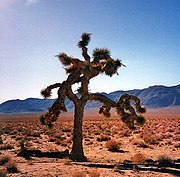
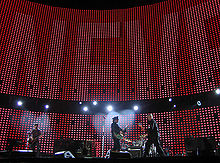


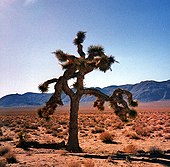

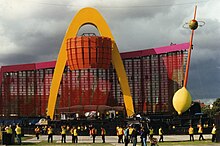


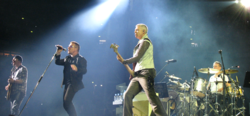
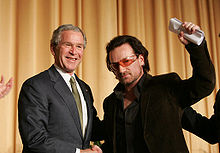

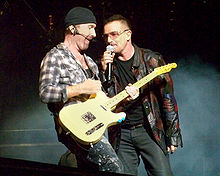



 留言列表
留言列表
 {{ article.title }}
{{ article.title }}

